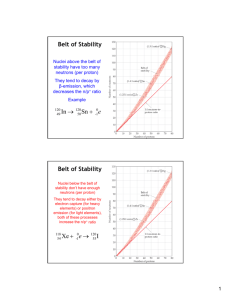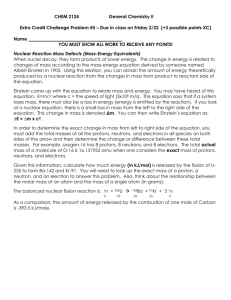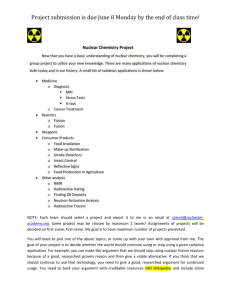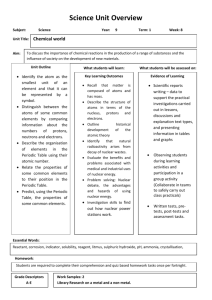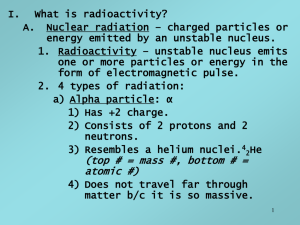Nuclear Chemistry
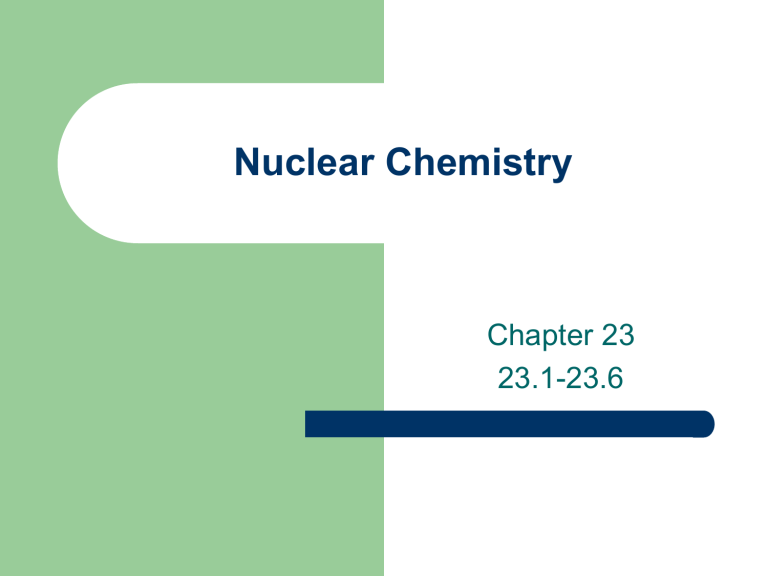
Nuclear Chemistry
Chapter 23
23.1-23.6
Nuclear Chemistry
Nuclear Chemistrythe study of reactions involving changes in atomic nuclei.
Importance
Disadvantages
Nuclear Reactions
Except for Hydrogen, all nuclei contain particles called protons and neutrons.
Nuclei can be stable or unstable.
Unstable Nuclei emit particles and/or electromagnetic radiation spontaneously.
Phenomenon is called Radioactivity.
Nuclear Transmutationresults from the bombardment of nuclei by neutrons, protons or other nuclei.
Nuclear Reactions
Atomic number (Z) = number of protons in nucleus
Mass number (A) = number of protons + number of neutrons
= atomic number (Z) + number of neutrons
Mass Number
Atomic Number
A
Z
X Element Symbol
Nuclear Reactions proton
1
1 p or
1
1 H neutron
1
0 n
0
-1 electron e or
-1
0 b positron
0
+1 e or
+1
0 b
4
2 a particle
He or
2
4 a
Balancing Nuclear Equations
1. Conserve mass number (A).
The sum of protons plus neutrons in the products must equal the sum of protons plus neutrons in the reactants.
235
92
U + 1
0 n 138
55
Cs +
96
37
Rb + 2 1
0 n
235 + 1 = 138 + 96 + 2x1
Balancing Nuclear Equations
2. Conserve atomic number (Z) or nuclear charge.
The sum of nuclear charges in the products must equal the sum of nuclear charges in the reactants.
235
92
U + 1
0 n 138
55
Cs +
96
37
Rb + 2 1
0 n
92 + 0 = 55 + 37 + 2x0
Balancing Nuclear Equations
212 Po decays by alpha emission. Write the balanced nuclear equation for the decay of 212 Po.
alpha particle -
4
2
He or
4
2 a
212
84
Po 4
2
He + A
Z
X
212 = 4 + A
84 = 2 + Z
A = 208
Z = 82
212
84
Po 4
2
He + 208
82
Pb
Chemical Reactions vs. Nuclear
Reactions
Nuclear Stability
Nucleus is very small
Contributes most of weight of atom
Extremely high density
Even higher # of particles
Nuclear Stability
Particles repel/attract each other
neutron-to-proton ratio
Predicting stability:
– Magic numbers: 2,8,20,50,82,126
–
–
–
Even numbers of neutrons and protons vs. odd numbers
All isotopes of elements with atomic numbers higher than 83 are radioactive.
All isotopes of Tc and Pm are radioactive.
n/p too large beta decay
X
Y n/p too small positron decay or electron capture
Nuclear Stability
Beta decay
14
6
C 14 N + 0 b
+ n
7 -1
40
19
K 40 Ca + 0 b
+ n
20 -1
Decrease # of neutrons by 1
Increase # of protons by 1
1
0 n 1 p + 0 b
+ n
1 -1
23.2
Nuclear Stability
Positron decay
11
6
C 11 B + 0 b
+ n
5 +1
Increase # of neutrons by 1
38
19
K 38 Ar + 0 b
+ n
18 +1
Decrease # of protons by 1
1
1 p 1 n + 0 b
+ n
0 +1 n and n have A = 0 and Z = 0
Nuclear Stability
Electron capture decay
37
18
Ar + 0 e 37 Cl + n
-1 17
55
26
Fe + 0 e 55 Mn + n
-1 25
Increase # of neutrons by 1
Decrease # of protons by 1
1
1 p + 0 e 1 n + n
-1 0
Nuclear Stability
Alpha decay
212
84
Po 4
2
He + 208
82
Pb Decrease # of neutrons by 2
Decrease # of protons by 2
Nuclear Binding Energy
Nuclear Binding Energythe energy required to break up a nucleus into its component protons and neutrons.
Necessity?
Mass Defect
Einstein’s Theory of Relativity
E = mc 2
Nuclear Binding Energy
E = mc 2
BE + 19
9
F 9 1
1 p + 10 1
0 n
BE = 9 x (p mass) + 10 x (n mass) – 19 F mass
BE (amu) = [(9 x 1.007825) + (10 x 1.008665)] – 18.9984
BE = 0.1587 amu
BE = 2.37 x 10 -11 J
1 amu = 1.49 x 10 -10 J
Nuclear Binding Energy binding energy per nucleon = binding energy number of nucleons
=
2.37 x 10 -11 J
19 nucleons
= 1.25 x 10 -12 J
Nuclear Binding Energy
Natural Radioactivity
Outside the belt of stability, nuclei are radioactive.
Radioactive nuclei spontaneously emit radiation.
–
α particles, β particles, γ rays, etc.
Disintegration of radioactive nucleus leads to a decay series.
Radioactive Decay--Dating
Uranium decay
After time, half of parent exsists
Equal amounts of parent and daughter
Age?
Nuclear Transmutations
Rutherford, 1919
Artificial Radioactivity
Nitrogen bombarded by α particles
14
7
N + 4 a
2
17 O + 1 p
8 1
Nuclear Transmutation
Notation for reactions
First Isotope (bombarding particle, ejected particle) Final Isotope
Notation for Nitrogen-14 bombarded with a particle.
Transuranium Elements
Synthetic elements
Atomic Numbers greater than 92
Particle Accelerator necessary for preparation
Particle Accelerator
Cyclotron Particle Accelerator
Nuclear Fission
Nuclear Fissionthe process in which a heavy nucleus (mass number > 200) divides to form smaller nuclei of intermediate mass and one or more neutrons.
Energy is released.
Uranium-235 was the first element discovered to go through nuclear fission.
Nuclear Fission
235
92
U + 1
0 n 90
38
Sr + 143
54
Xe + 3 1
0 n + Energy
Nuclear Fission
Nuclear chain reaction is a self-sustaining sequence of nuclear fission reactions.
The minimum mass of fissionable material required to generate a self-sustaining nuclear chain reaction is the critical mass .
Chain Reaction
Non-critical
Critical
The Atomic Bomb
Nuclear Reactors
Peaceful application of nuclear fission
Generates electricity from chain reactions
Provides 20% of electricity in U.S.
Light water reactors; Heavy water reactors;
Breeder reactors
Light Water Reactors
Most U.S. nuclear reactors are light water
Light Hydrogen
Use Uranium-235 under controlled conditions
Releases large quantities of steam
Steam drives electric generators
Needs large amounts of coolant
Plants built by lakes and rivers
Large amounts of thermal pollutant
Light Water Reactors
Heavy Water Reactors
Uses Deuterium D
2
O
D absorbs neutrons less efficiently than H
Does not require U-235
Neutrons leak out of reactor
Expensive to prepare D
2
O
Environmentally friendly
Breeder Reactors
Breeder Reactoruses uranium fuel, but unlike a conventional nuclear reactor, it produces more fissionable materials than it uses.
Converts uranium-238 to plutonium-239 in a 3 step process.
Plutonium-239 undergoes fission
Reactor produces 1 mole of p-239 for every 1 mole used.
Takes 7-10 years for complete regeneration.
Hazards of Nuclear Energy
Production of radioactive isotopes with long half-lives (24,400 years)
Radioactive and toxic substances
Three-mile Island Reactor- radiation escaped
Chernobyl Nuclear Plant- fire and explosion
Accidents
Waste Disposal
Nuclear Fusion
Nuclear Fusionthe combining of small nuclei into larger ones.
Two small nuclei can combine and release large amounts of energy
To occur, the nuclei must be in an environment with high temperature.
Thermonuclear Reactions
Nuclear fusion occurs constantly on the Sun.
Nuclear Fusion
How do we get it to occur?
Container?
The Hydrogen Bomb
Thermonuclear Bomb
All power and no control
Fusion reaction then fission reaction
Fusion reaction creates high temp. for fission reaction
Bombs usually contain Co-59 and upon explosion convert to Co-60
